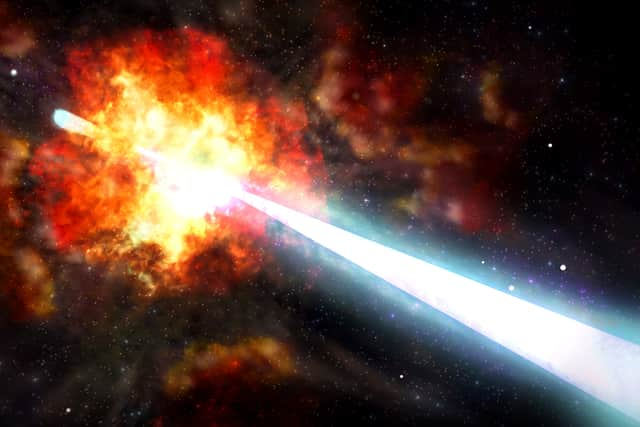Gamma ray burst: what are GRBs, cosmic explosion that blinded space instruments explained - how bright was it?
and live on Freeview channel 276
Astronomers have said that a cosmic explosion two billion light-years from Earth that blinded space instruments may be the brightest ever observed.
In October of last year, the explosion sent a pulse of powerful radiation through the solar system, setting off detectors on numerous spacecraft. Scientists said this type of event is a gamma-ray burst (GRB), which are some of the strongest and brightest explosions in the universe.
Advertisement
Hide AdAdvertisement
Hide AdThis GRB was deemed so exceptional that astronomers said it was the brightest of all time (BOAT) since the beginning of human civilisation. Researchers said the event, dubbed GRB 221009A, blinded most gamma-ray instruments in space.
This meant astronomers could not measure the real intensity of the emission and had to reconstruct its energy expenditure from past and present data. Here is everything you need to know about it.
How bright was it?


GRBs are the most energetic explosions in the universe, emitting extremely high-energy gamma-rays for several seconds to several minutes. They were first detected in the late 1960s by the US Vela satellites, which were originally designed to monitor nuclear tests.
An analysis of 7,000 GRBs suggests that GRB 221009A is 70 times brighter than any yet seen and an event like this occurs once every 10,000 years.
Advertisement
Hide AdAdvertisement
Hide AdDr Dan Perley, of the Astrophysics Research Institute at Liverpool John Moores University – who followed the event with the University’s Liverpool Telescope on the Spanish island of La Palma, said: “There is nothing in human experience that comes anywhere remotely close to such an outpouring of energy. Nothing.”
Dr Perley said the event GRB 221009A produced “a phenomenal amount of energy”, adding: “It’s certainly the highest value ever recorded for a gamma-ray burst.”
According to the European Space Agency (ESA), the blast deposited around a gigawatt of power into Earth’s upper atmosphere – the equivalent of a power station’s energy output.
It is thought that GRB 221009A was so bright because it was much closer to Earth compared to other known GRBs and the beam of electromagnetic radiation happened to be pointing in the direction of the planet.
Advertisement
Hide AdAdvertisement
Hide AdGRBs are usually followed by a shockwave that emits lower energy radiation, known as an afterglow, that gradually fades over time.
How do gamma-ray bursts occur?
GRBs are thought to be produced by the collapse of massive stars, typically more than 10 times the mass of our sun, or the collision of two neutron stars. When a massive star runs out of fuel and can no longer produce energy from nuclear fusion, it will collapse under the force of gravity.
This collapse can trigger a supernova explosion, which releases an enormous amount of energy, including a jet of matter and radiation. The jet is made up of plasma, which is a hot, ionised gas, and it moves at nearly the speed of light.
As the jet moves through the surrounding interstellar medium, it creates a shock wave that accelerates particles to extremely high energies, producing the gamma-ray emission.
Advertisement
Hide AdAdvertisement
Hide AdAstronomers believe GRB 221009A is a result of a massive star collapsing in on itself to form a black hole. Dr Perley said: “The star would have been many times more massive than the Sun, probably 20 times as massive or more.”
GRBs also produce a supernova but astronomers are yet to ascertain whether that occurred in this case. Andrew Levan, a professor of astrophysics at Radboud University in Nijmegen, Netherlands, said: “We cannot say conclusively that there is a supernova, which is surprising given the burst’s brightness. If it’s there, it’s very faint.”
What can the research tell us?
Gamma-ray bursts are extremely rare, with only a handful detected each year. However, they are important astrophysical events that provide information about the early universe and the physics of extreme environments.
Dr Gavin Lamb, a Royal Society Dorothy Hodgkin Research Fellow at Liverpool John Moores University – who was part of an international team that used Nasa’s James Webb Space Telescope to observe the GRB 221009A afterglow, said the observations provide “a unique insight into the mechanisms responsible for these transient flashes of light”.
Advertisement
Hide AdAdvertisement
Hide AdHe said: “There is a lot more data yet to sift through and we will be looking for clues to explain the relationship between GRBs and supernovae from massive stars, and the dynamics within the afterglow. We still don’t fully understand many aspects of such high-energy jets.”
Comment Guidelines
National World encourages reader discussion on our stories. User feedback, insights and back-and-forth exchanges add a rich layer of context to reporting. Please review our Community Guidelines before commenting.
